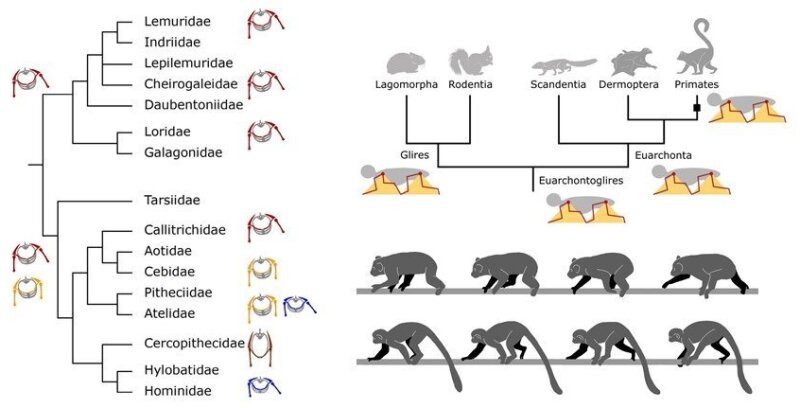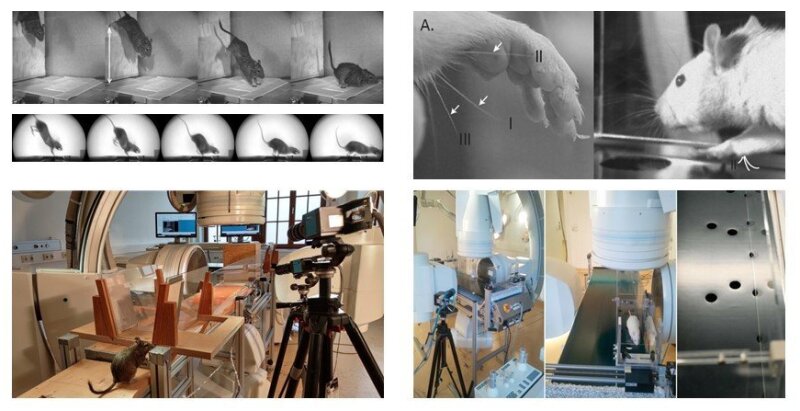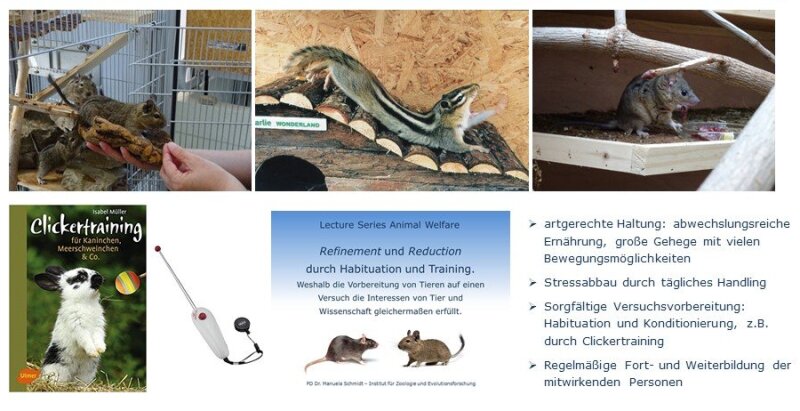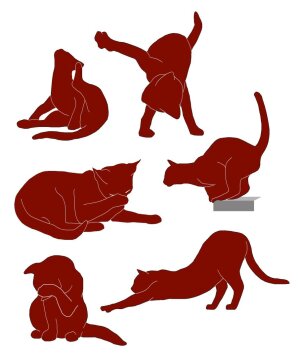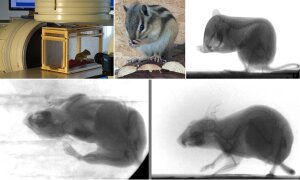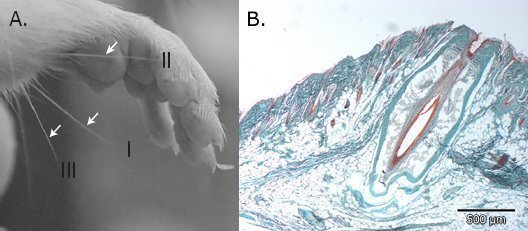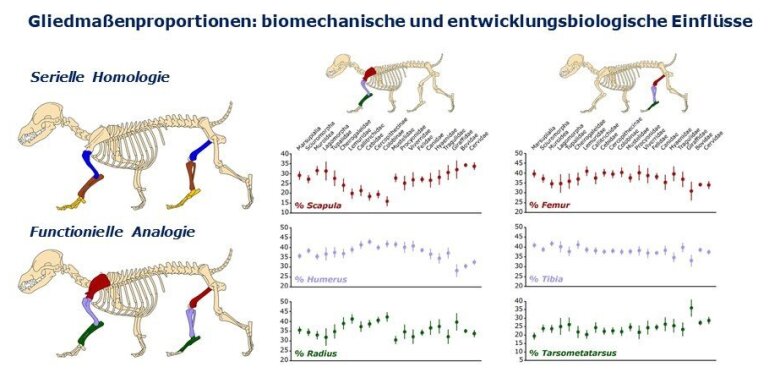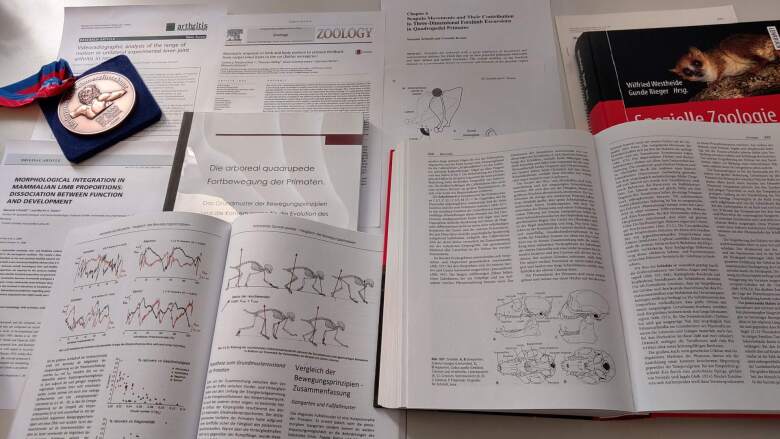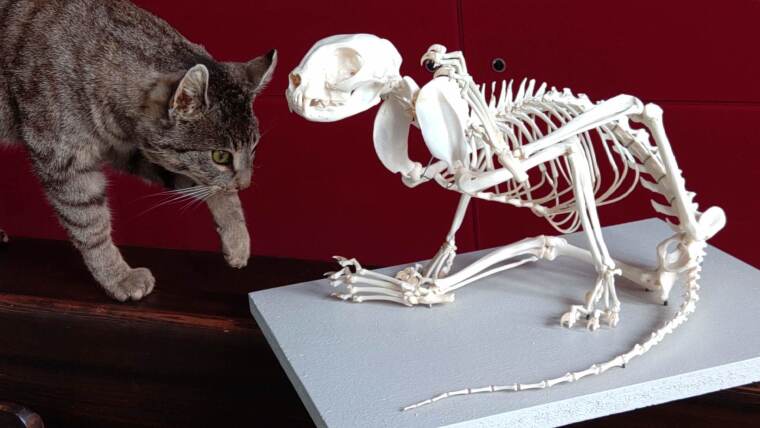
PD Dr. Manuela Schmidt
Foto: Manuela SchmidtKontakt
PD Dr. Manuela Schmidt
Akademische Rätin
Kuratorin der Sammlungen des Phyletischen Museums
Institut für Zoologie und Evolutionsforschung
Erbertstrasse 1
07743 Jena
Tel.: +49 3641 949188
Email: schmidt.manuela@uni-jena.de
Forschung
Kernthemen meiner wissenschaftlichen Tätigkeit liegen in der evolutionären und funktionellen Morphologie des Bewegungssystems der Säugetiere. Meine Fragen richten sich auf die Möglichkeiten und Grenzen der biologischen Anpassung in diesem multifunktionalen System sowohl auf der Ebene der Struktur als auch auf der Ebene der Funktionsweisen.
Meine Forschungsmethode ist der Vergleich von Organismen vor dem Hintergrund einer Phylogenie-Hypothese. Die Techniken reichen von hochauflösender Röntgenvideographie, Computertomographie und Elektromyographie in der Funktionsanalyse bis hin zur Geometrischen Morphometrie, Histologie und Immunhistochemie in der Strukturanalyse.
Evolutive Transformationen bei Primaten: Schulterbeweglichkeit, Gangarten, Beingeometrie
Illustration: Manuela SchmidtBewegungsanalyse
Kleine Säugetiere haben ein besonders vielseitiges Bewegungsrepertoire. Wir untersuchen das Laufen auf geraden und geneigten Flächen, auf schmalen Ästen und auf unebenem Grund. Die Analyse des Kletterns und Springens erfordert eine besonders gute Vorbereitung der Tiere und Versuchssituationen.
Biplanare Röntgenvideographie ermöglicht den Blick auf die sich bewegenden Strukturen unter dem Fell. Messplatten ermitteln mit hoher Präzision die Kräfte beim Laufen und Springen.
Experimentelle Situationen im Bewegungslabor
Illustration: Manuela SchmidtTierwohl in der Bewegungsforschung
Unsere Forschung und die Qualität unserer Daten ist maßgeblich bestimmt durch die Kooperation von und mit Tieren. Unsere Projekte sind so gestaltet, dass den Tieren keine Leiden und Schmerzen widerfahren. Wir investieren viel Zeit und Geduld in die Habituation, um Stressbelastungen zu minimieren. Alle an den Projekten beteiligten Personen verfügen über die vorgeschriebene Sachkenntnis und bilden sich regelmäßig fort. Auch unsere Erfahrungen, z.B. über die Vorteile des Clickertrainings teilen wir im Rahmen von Vorträgen und Publikationen.
Maßnahmen zur Erhaltung des Tierwohls
Illustration: Manuela SchmidtAktuelle Projekte:
Multifunktionalität in Bewegungssystemen.
Illustration: Manuela SchmidtMultifunktionalität in Bewegungssystemen.
Die überwiegende Mehrzahl der Säugetiere zeichnet sich durch geringgradige Spezialisierungen an bestimmte Bewegungsweisen aus. Langfristig evolutiv erfolgreich sind eher diejenigen Arten mit breitem Bewegungsrepertoire und multifunktionalem Bewegungsapparat. Bezogen auf die Morphologie des Bewegungssystems bezeichnen wir solche Arten oft als "Generalisten". Statt in einer Spezialdisziplin Bestleistungen zu erzielen, können sie laufen, klettern, springen, graben und vieles mehr. Sie sind darin nicht exzellent, aber gut genug, um den Anforderungen ihres jeweiligen Lebensraumes gerecht zu werden.
Ein Schlüssel zum Verständnis dieser Multifunktionalität sind die Bewegungsprinzipien, also die Art und Weise, wie Bewegungen ausgeführt, Kräfte generiert und Muskeln aktiviert werden.
- Hier untersuchen wir, wie ausgewählte Arten diese Bewegungsprinzipien anpassen, um bestimmte Leistungen zu erbringen.
Körperpflege: röntgenvideographische Untersuchung der Bewegungsweisen bei kleinen Nagetieren
Illustration: Manuela SchmidtFortbewegung ist nicht alles, was das Überleben sichert. Seit Säugetiere ein Fell haben, haben sie auch Parasiten. Körperpflege ist überlebensnotwendig. Sie schützt nicht nur vor Krankheitserregern, die von Parasiten übertragen werden, sondern erhält u.a. die Funktionsfähigkeit wichtiger Sinne wie Gehör und den Tastsinn. Körperpflege spielt eine große Rolle für die Thermoregulation und für soziale Interaktionen aller Art. Kein Wunder, dass viele Arten mehr Zeit in die tägliche Körperpflege investieren als in andere Aktivitäten.
- Wir untersuchen, wie Säugetiere sich putzen, welche Bewegungen hier wichtig sind und welche möglichen Anpassungen sich im Laufe der Evolution an diese Aufgabe entwickelt haben.
Mitwirkende Studentinnen und Studenten:
B.Sc. Celina Richter, M.Sc. Julia van Beesel, M.Sc. Janina Weber
Streifenhörnchen (Tamias sibiricus, Sciuridae) verbringen viel Zeit mit der täglichen Fellpflege. Durch Analysen der räumlich-zeitlichen Struktur dieser Putzsequenzen erfahren wir, welches Körperareal besonders intensiv gereinigt wird, welche Bereiche vernachlässigt werden und womit sich die Tiere bevorzugt reinigen (orale Fellpflege, Kratzen, "Waschen" mit Vorderpfoten).
Weitere Themen und abgeschlossene Projekte
-
Carpale Vibrissen: Biologische und Technische Charakterisierung.
A. Carpale Sinushaare am Handgelenk der Ratte. B. Längsschnitt durch den Follikel-Sinus-Komplex.
Foto: Sandra Niederschuh, Manuela SchmidtMany small-sized mammals have three or more sinus hairs near the wrist joint of the forelimb, called "carpal vibrissae". Sandra Niederschuh in her PhD. project investigates the function of these hairs as feedback sensors during locomotion. She analysed the effect of removal of these hairs (they regenerate within two weeks) on limb kinematics and body posture.
Our biological perspective on carpal vibrissae is embedded in a collaborative project with engineers and scientists of the Technical University Ilmenau. Together, we explore how technical solutions for lever-based mechanosensors can be realized according to the function of vibrissae.
Projektpartner:
- Prof. Dr.-Ing. habil. Klaus Zimmermann (FG Technische Mechanik der TU Ilmenau)
- Prof. Dipl.-Ing. Dr. med. habil. Hartmut Witte (FG Biomechatronik der TU Ilmenau)
Projektförderung:
DFG-Projekt (2013, 2015): Technische, nicht-visuelle Charakterisierung von Substratkontakten nach dem biologischen Vorbild carpaler Vibrissen.
-
Diagnostisches Potenzial der Bewegungsanalyse
Behavioural and performance analyses become of increasing importance as diagnostic tools in preclinical medical research and genetics. But, linking anatomy and physiology with behaviour and performance is difficult because of individual variation and flexibility in the latter. The analysis of motion principles e.g. the footfall patterns of gaits, the measures of speed changes, limb and body kinematics or substrate reaction forces in animal models for diseases or in mutants has the potential to explain observed differences in performance and behaviour between treated and control individuals.
Evolutionary morphology also profit from such studies by learning much about intraspecific physiological and functional plasticity of the motion system, about morphological integration and about the ability to compensate for a lesion in the central nervous system, for a dysfunction of a certain joint or for an genetic aberration.
Projekte:
- The Role of the Wilms Tumor Suppressor Gene Wt1 in the Neural Control of Locomotion in Mice. Projektpartner: Prof. Dr. Christoph Englert, Dr. Danny Schnerwitzki (Forschungsgruppe Molekulare Genetik, Leibnitz-Institut für Altersforschung: Fritz-Lipmann-Institut e.V. Jena).
- Integratives und diagnostisches Potential einer differenzierten Bewegungsanalyse in der Schmerzforschung. Projektpartner: Dr. Michael Böttger, Johannes Leuchtweis, Prof. Dr. Hans-Georg Schaible (Institut für Physiologie I / Neurophysiologie, Universitätsklinikum Jena). Projektförderung: ProChance, Programm zur Förderung der Chancengleichheit von Frau und Mann in der Wissenschaft (2009).
-
Morphologische Integration und Gliedmaßenproportionen
Morphologische Integration: Gliedmaßenproportionen bei Säugetieren
Illustration: Manuela SchmidtDuring mammalian evolution, fore- and hindlimbs underwent a fundamental reorganization in the transformation from the sprawled to the parasagittal condition. This caused a dissociation between serial and functional homologues. The mobilized scapula functions as the new proximal forelimb element and is functionally analogous to the femur of the hindlimb. Tarsus and metatarsus built a new functional hindlimb element that is functionally analogous to the forearm of the forelimb. Morphological covariation between serially homologous fore- and hindlimb elements can conflict with biomechanical demands when certain intralimb proportions are required for the postural stability of motion.
In our studies we found a clear relationship between the proportions of the first and the third elements of each limb, while the middle element is less involved in alterations of intralimb proportions. Hindlimb proportions are largely uniform across mammals and correspond to biomechanical predictions regarding postural stability. The greater variability in forelimb proportion is likely be the expression of various adaptations but might results also from constraints due to the shared developmental programs with the hindlimb.
Projektpartner:
- Prof. Dr. André Seyfarth (heute: Sportbiomechanik am Institut für Sortwissenschaft der TU Darmstadt)
- Prof. Dr. Lena Zentner (heute: FG Nachgiebige Systeme der TU Ilmenau)
Projektförderung:
Hochschul- und Wissenschaftsprogramm zur Förderung exzellenter wissenschaftlicher Aktivitäten an Thüringer Hochschulen (2005 - 2010): Nachwuchsgruppe "Funktionelle Morphologie von Bewegungssystemen".
DFG Projekt (2006-2009): Größenabhängige Strategien der Selbststabilisierung der Beinbewegung. (Fischer & Schmidt)
-
Fortbewegung der Primaten: Grundmuster und evolutive Transformationen
Inhalt
-
Funktionelle Morphologie der Schulter bei Primaten
Projektförderung:
DFG Projekt (2005 - 2008): Verteiling der Muskelfasertypen in der Schultermuskulatur arborealer Primaten in Relation zu Schulterbewegung und Belastung.
Bibliographie
-
2020 - heute
Buchbeiträge, Monographien und wichtige Fachpublikationen
Foto: Manuela Schmidt- Schnerwitzki, D.; Englert, C.; Schmidt, M. (2023): Adapting the pantograph limb: Differential robustness of fore- and hindlimb kinematics against genetically induced perturbation in the neural control networks and its evolutionary implications. Zoology 157. doi.org/10.1016/j.zool.2023.126076Externer Link
- Niederschuh, S.J.; van Beesel, J.; Schmidt, M. (2022): The role of sensory feedback from carpal sinus hairs in locomotor kinematics of rats (Rattus norvegicus, Rodentia) during walking on narrow substrates. Zoology 155. doi.org/10.1016/j.zool.2022.126055Externer Link.
-
2015 - 2019
- Schnerwitzki, D.; Perry, S.; Ivanova, A.; Caixeta, F.V.; Cramer, P.; Günther, S.; Weber, K.; Tafreshiha, A.; Becker, L.; Vargas Panesso, I.L.; Klopstock, T.; Hrabe de Angelis, M.; Schmidt, M.; Kullander, K.; Englert, C. (2018): Neuron-specific inactivation of Wt1 alters locomotion in mice and changes interneuron composition in the spinal cord. Life Science Alliance e201800106. doi: 10.26508/lsa.201800106.Externer Link
- Niederschuh, S.; Helbig, T.; Zimmermann, K.; Witte, H.; Schmidt, M. (2017): Kinematic response in limb and body posture depending on sensory feedback from carpal sinus hairs in the rat (Rattus norvegicus). Zoology 121, 18-34. IF 1.59
- Schmidt, M.; Mehlhorn, M.; Fischer, M.S. (2016): Shoulder girdle rotation, forelimb movement, and the influence of carapace shape on locomotion in Testudo hermanni (Testudinidae). Journal of Experimental Biology 219, 2693-2703. IF 3.02
- Volkova, T.; Zeidis, I.; Witte, H.; Schmidt, M.; Zimmermann, K. (2016): Analysis of the vibrissa parametric resonance causing a signal amplification during whisking behaviour. Journal of Bionic Engineering 13, 312-323. IF 2.46
- Hunt, A.; Schmidt, M.; Fischer, M.; Quinn, R. (2015): A Biologically Based Neural System Coordinates the Joints and Legs of a Tetrapod. Bioinspiration and Biomimetics 10, 055004. IF 3.13
- Niederschuh, S.; Witte, H.; Schmidt, M. (2015): The role of vibrissal sensing in forelimb position control during travelling locomotion in the rat (Rattus norvegicus, Rodentia). Zoology 118, 51-62. IF 1.59
- Hesse, B.; Nyakatura, J.A.; Fischer, M.S.; Schmidt, M. (2015): Adjustments of limb mechanics in cotton-top tamarins to moderate and steep support orientations: significance for the understanding of early primate evolution. Journal of Mammalian Evolution 22, 435-450. IF 2.38
-
2010 - 2014
- Helbig, T.; Voges, D.; Niederschuh, S.; Schmidt, M.; Witte, H. (2014): Characterizing the substrate contact of carpal vibrissae of rats during locomotion. In: Biomimetic and Biohybrid Systems. Lecture Notes in Computer Science Volume 8608, pp 399-401.
- Hunt, A.; Schmidt, M.; Arnold, D.; Fischer, M.; Quinn, R. (2014): Neuromechanical simulation of inter-leg controller for tetrapod coordination. In: Biomimetic and Biohybrid Systems. Lecture Notes in Computer Science Volume 8608, pp 142-153.
- Schmidt, M.; Witte, H.; Zimmermann, K.; Niederschuh, S.; Helbig, T.; Voges, D.; Husung, I.; Volkova, T.; Will, C.; Behn, C.; Steigenberger, J.; Klauer, G. (2014): Technical, non-visual characterization of substrate contact using carpal vibrissae as a biological model : an overview. In: Shaping the future by engineering : 58th IWK, Ilmenau Scientific Colloquium, Technische Universität Ilmenau, 15 p.
- Böttger, M.K; Leuchtweis, J.; Schaible, H.-G.; Schmidt, M. (2011): Videoradiographic analysis of the range of motion in unilateral experimental knee joint arthritis in rats. Arthritis Research and Therapy 13, R79. IF 4.27
- Schmidt, M. (2011): Locomotion and postural behaviour. Advances in Science and Research 5, 23-39.
- Preuschoft, H.; Hohn, B.; Scherf, H.; Schmidt, M.; Krause, C.; Witzel, U. (2010): Functional analysis of the primate shoulder. International Journal of Primatology 31, 301-320. IF 1.29
-
2000 - 2009
- Böttger, M.K.; Weber, K.; Schmidt, M.; Gajda, M.; Bräuer, R.; Schaible, H.-G. (2009): Gait abnormalities differentially indicate pain or structural joint damage in monoarthicular antigen-induced arthritis. Pain 145, 142-150. IF 6.03
- Schmidt, M.; Fischer, M.S. (2009): Morphological integration in mammalian limb proportions: dissociation between function and development. Evolution 63, 749-766. IF 3.57
- Schmidt, M. (2008): Forelimb proportions and kinematics: How are small primates different from other small mammals? Journal of Experimental Biology 211, 3775-3789. IF 3.02
- Schmidt, M.; Schilling, N. (2007): Fiber type distribution in the shoulder muscles of tree shrews, cotton-top tamarins, and squirrel monkeys related to shoulder movements and forelimb loading. Journal of Human Evolution 52, 401-419. IF 3.99
- Nyakatura, J.; Fischer, M.S.; Schmidt, M. (2007): Gait parameter adjustments of cotton-top tamarins (Saguinus oedipus, Callitrichidae) to locomotion on inclined arboreal substrates. American Journal of Physical Anthropology 135, 13-26. IF 2.82
- Schmidt, M. (2005): Quadrupedal locomotion in squirrel monkeys (Cebidae: Saimiri sciureus) - A cineradiographic study of limb kinematics and related substrate reaction forces. American Journal of Physical Anthropology 128, 359-370. IF 2.82
- Schmidt, M. (2005): Hind limb proportions and kinematics: are small primates different from other small mammals? Journal of Experimental Biology 208, 3367-3383. IF 3.02
- Preuschoft, H.; Schmidt, M.; Hayama, S.; Okada, M. (2003): The influence of three-dimensional movements of the forelimb on the shape of the thorax and its importance for erect body posture. Courier Forsch.-Inst. Senckenberg 243, 9-24.
- Witte, H.; Fischer, M.S.; Schmidt, M.; Gruber, S.; Ludwig, O.; Hackert, R.; Schilling, N.; Voges, D.; Hoffmann, H.; Preuschoft, H. (2003): Human bipedality: mechanical preconditions and morphological adaptations. Courier Forsch.-Inst. Senckenberg 243, 25-34.
- Fischer, M.S.; Schilling, N.; Schmidt, M.; Haarhaus, D.; Witte, H. (2002): Basic limb kinematics of small therian mammals. Journal of Experimental Biology 205, 1315-1338. IF 3.02
- Schmidt, M.; Voges, D.; Fischer, M.S. (2002): Shoulder movements during quadrupedal locomotion in arboreal primates. Z. Morph. Anthropol. 83, 235-242.
- Witte, H.; Biltzinger, J.; Hackert, R.; Schilling, N.; Schmidt, M.; Reich, C.; Fischer, M.S. (2002): Torque patterns of the limbs of small therian mammals during locomotion on flat ground. Journal of Experimental Biology 205, 1339-1353. IF 3.02
- Schmidt, M.; Fischer, M.S. (2000): Cineradiographic study of forelimb movements during quadrupedal locomotion in the brown lemur (Eulemur fulvus, Primates: Lemuridae). American Journal of Physical Anthropology 111, 245-262. IF 2.82
-
Buchbeiträge und Monographien
Buchbeiträge
- Schmidt, M. (2014): Primates. In: Lehrbuch der Speziellen Zoologie. Band 2 Wirbel- oder Schädeltiere. 3. Aufl. (eds. W. Westheide & G. Rieger) pp. 564-592. Spektrum Verlag, Heidelberg.
- Schmidt, M.; Krause, C. (2011): Scapula movements and their contribution to three-dimensional forelimb excursions in quadruped primates. In: Primate Locomotion: Linking Field and Laboratory Research. (eds. K. D'Aout & E.E. Vereecke). pp. 83-108. Book in the series "Developments in Primatology: Progress and Prospects" Series Editor R.H. Tuttle, Springer Science & Business Media LLC, New York.
- Schmidt, M. (2010): Primates. In: Lehrbuch der Speziellen Zoologie. Band 2 Wirbel- oder Schädeltiere. 2. Aufl. (eds. W. Westheide & G. Rieger) pp. 564-592. Spektrum Verlag, Heidelberg.
- Schmidt, M. (2006): Primate Locomotion. In: Encyclopedia of Anthropology. (ed. J. Birx) pp. 1938- 1939. SAGE Publications, Thousand Oaks, California.
- Witte, H.; Hackert, R.; Lilje, K.E.; Schwerda, D.; Schilling, N.; Schmidt, M.; Freitag, S.; Seyfarth, A.; Ilg, W.; Blickhan, R.; Fischer, M.S. (2001): Some principles and some constraints of scaling in the locomotor apparatus of quadruped animals and animates. In: Similarity Methods. (eds. B. Kröplin, S. Rudolph, S. Brückner) pp. 149-151. Institut für Statik und Dynamik der Raumfahrtkonstruktionen der Universität Stuttgart, Stuttgart.
- Witte, H.; Schilling, N.; Hoffmann, H. Hackert, R.; Voges, D.; Lilje, K.E.; Schmidt, M.; Fischer, M.S. (2002): Der Rumpf wird vom Menschen und von anderen Säugetieren systematisch für die Fortbewegung genutzt. In: Prävention von arbeitsbedingten Gesundheitsgefahren und Erkrankungen. (eds. R. Grieshaber, W. Schneider & Scholle, H.C.) pp. 291-304. 8. Erfurter Tage. Monade Agentur für Kommunikation, Leipzig.
Monographien
- Schmidt, M. (2010): Die arboreal quadrupede Fortbewegung der Primaten. Das Grundmuster der Bewegungsprinzipien und die Konsequenzen für die Evolution des Bewegungssystems der Primaten." Habilitationsschrift.Externer Link 1-152.

